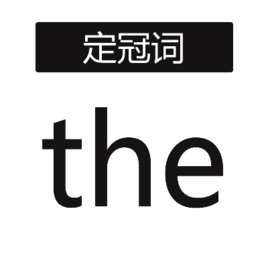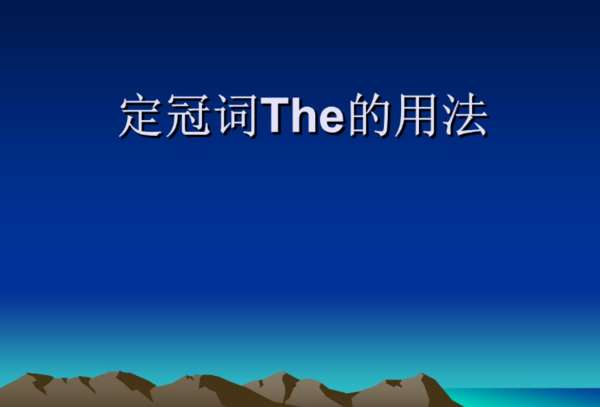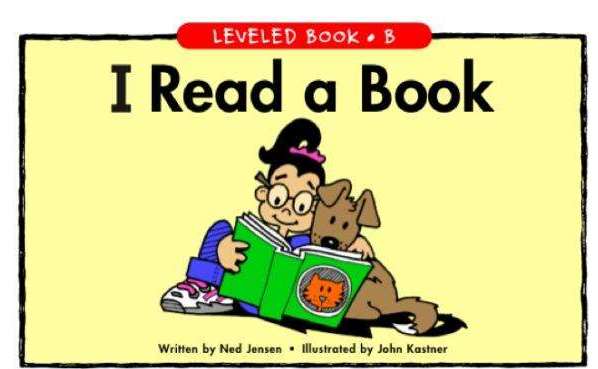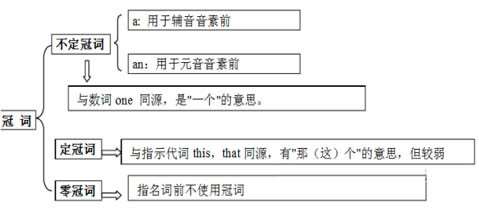定冠词the的用法
曲谱自学网今天精心准备的是《定冠词the的用法》,下面是详解!
定冠词the的用法中什么情况不加the
下列八种情况不能使用定冠词the。
一、定冠词不与表示一类人或事物的复数名词连用。例如:
1. I like reading the books.(×)I like reading books.(√)
2. She likes the cats.(×)She likes cats.(√)
二、定冠词不能用在某些习惯用语中的名词前面。例如:
1. I have lunch at the noon.(×)I have lunch at noon.(√)
2. We go to school by the bus.(×)We go to school by bus.(√)
三、定冠词不能用在某些专用名词和不可数名词前面。例如:
1. I like the China.(×)I like China.(√)
2. Would you like a cup of the water? (×)
Would you like a cup of water?(√)
四、定冠词不能用在节日、日期、月份、季节前面。例如:
1. Today is the Teachers' Day. (×)
Today is Teachers' Day.(√)
2. He was born in the May in 1987. (×)
He was born in May in 1987. (√)
五、定冠词不能用在表示称呼语或某些头衔的名词前面(尤其作表语、宾补时)。例如:
1. Good morning,the sir!(×)
Good morning,sir! (√)
2. I need some help,the Mummy.(×)
I need some help,Mummy.(√)
六、定冠词不能与名词前已有作定语用的this,that,my,your,some,any等代词连用。例如:
1. This the pen is mine. (×)
This pen is mine.(√)
2. I have the some money. (×)
七、定冠词不能用在表示科目名词的前面。例如:
1. We will learn the Chinese, the history and the Maths this afternoon. (×)
We will learn Chinese, history and Maths this afternoon.(√)
2. The English is the most interesting of all the subjects.(×)
English is the most interesting of all the subjects.(√)
八、定冠词不能用在三餐和球类运动名词的前面。例如:
1. She goes to school after the breakfast every morning.(×)
She goes to school after breakfast every morning.(√)
2. We often play the football after school. (×)
We often play football after school. (√)
定冠词的the的用法口诀
定冠词的the的用法口诀是什么?定冠词的用法又是什么呢?...
定冠词的the的用法口诀是什么?定冠词的用法又是什么呢?
定冠词the的用法口诀是:
特指双熟悉,上文已提及。世上独无二,序数最高级。
某些专有名,习语及乐器。有水无湖就用the
定冠词的用法如下:
一、用在表示方向、方位的名词前。如:
the right 右边;the left 左边 ;the east 东方;the west 西方
二、用在前面已提到过的人的身体部位或衣着的名词前 这种用法是先把整个对象说出来,然后再说到那个对象的身体的局部或衣着。 结构:动词+sb.+介词+身体部位或衣着。例句:
He touched her on the shoulder.
翻译: 他碰了碰她的肩。
三、与复数名词连用,指整个群体。 例句:
They are the teachers of this school.(指全体教师)
翻译:他们是这个学校的教师。
四、用在姓氏的复数形式前,表示全家人或这一姓的夫妇二人 。例句:
The Greens will move to the country.
翻译:格林一家要搬到乡下去。
五、用在逢十的复数数词前,表示年代,也指人的大约岁数。例句:
The old man is in the seventies.
翻译:老人大约七十几岁。
六、用在专有名词前,专有名词指国家机关、团体、阶级等。如:
the United Nations 联合国
the Great Wall 长城
七、用在第二次提到的人或事物的名词前。例句:
I read a story yesterday. Thestory was very interesting.
翻译:昨天我读了一个故事,那个故事很有趣。
八、定冠词与表示计量单位的名词连用,含有“每”“每一”的意思。例句:
The cloth is sold by theyard.
翻译:这种布按码出售。
九、当名词被一短语或从句所修饰时,名词前用定冠词。
Thebox on the desk is hers.
翻译:书桌的上的盒子是她的。
不定冠词a、an和定冠词the的用法有什么区别?
所谓冠词:是说明名词所表示的人或事物的一种虚词(总与名词连用,位于名词前,本句不能独立使用,关于a/an与the的区别与联系:
定冠词the是起修饰限定作用的冠词,它与指示代词this,that同源,表示“这个”或“那个”。
1 定冠词用在名词前,表示特指,即某个特定的人、事物等。特别是当某名词后面有定语限定这一名词时,名词前面一般都要用定冠词the
We have found the book that we lost yesterday. 我们已经找到了昨天丢的那本书。 Do you know the man standing by the window? 你认识那个站在窗户旁边的人吗?
How do you like the rooms here? 你觉得这里的房间怎么样?
2 用于单数名词前,指一类事物 The lion is a wild animal. 狮子是野生动物。
The compass was invented in China. 指南针是中国发明的。
The wolf hunts by night. 狼夜间出来觅食。
3 用于乐器名称前
the violin 小提琴 the piano 钢琴
4 用于世界上独一无二的事物前
the sun 太阳 the earth 地球 the world 世界 the nature 自然界
the sky 天空 the universe 宇宙
5 用在形容词前,表示一类人或事物
the poor 穷人 the blind 盲人 the aged 老人 the impossible 不可能的事情
6 用于构成形容词或副词的比较级和最高级形式
He runs the fastest. 他跑得最快。
Is this the best choice he can make? 这是他能做出的最好的选择吗?
二、 不定冠词的用法
1 不定冠词a表示“一”这一概念时,意思与one相似
There's a pen on the desk. 桌子上有一枝钢笔。
但是,除表示“一”这一数量外,很多情况下 a 与可数名词一起表示一类事物或者泛指概念。 I need a pencil now. 我现在需要(一)枝铅笔。(不确指哪枝铅笔)
We can't say a boy is cleverer than a girl. 我们不能说男孩比女孩聪明。(表示类别)
2 不定冠词在表示“一”的概念时,是非强调性的。如果强调“一”这一数量,常常用one
National Day is a two-day holiday. 国庆节是(一)个两天的假日。
We have only one day left to finish the task. 我们只剩下一天时间来完成这个任务。
3 不定冠词用在表示数量、时间等名词前,表示“每一(单位)…的价格、速度、顺序等”
The apples are two yuan a kilogram. 这些苹果每公斤两元钱。
Tom drives a car at 60 miles an hour. 汤姆以每小时60英里的速度开车。
I go back home once a month. 我每月回家一次。
4 不定冠词用于单数可数名词前,泛指人的职业、国籍、宗教等
He is a Christian. 他是基督徒。
My friend, Asaku, is a Japanese. 我的朋友Asaku是日本人。
He was a teacher in the past. But he is a businessman now. 过去他是教师,但现在他是生意人。 He was made a dean. 他被任命为主任。
5 不定冠词用在人名或表示人的名词前,表示不确定性,即说话人不清楚或没有指明所提到的人到底是谁
A Smith called you just now. 刚才一个叫史密斯的人给你找电话。
A comrade is waiting for you outside. 一个同志在外面等你。
6 不定冠词用于be of a (an)+noun结构中,表示“相同…的”
Tom and his sister are of a height. 汤姆和他的妹妹身高相同。
These sweaters are of a size. 这些毛衣大小相同。
7 不定冠词用于固定结构quite/half/rather/many/what/such a (an)+名词或so/too/how+形容词+a(an)+noun中,表示程度、数量或感叹等
It takes half an hour to get there. 到那里需要半小时。
He's quite a famous artist. 他是个很有名的艺术家。
Many a man would welcome such an opportunity. 许多人会很高兴有这样一个机会。
What a fool he is! 他多傻啊!
It's too difficult a problem for him. 对他来说,这是一个太难的问题。
8 不定冠词用于某些习惯用语或谚语中
in a word 总而言之 take a walk 散步 at a time 一次
注:当一篇文章中第一次提到某一事物时,在名词前面要加不定冠词,以后再次提到同一事物时用定冠词。
英语定冠词the详细用法
一定要最全的,最详细的,网上说的也有。我就是想要所有的the的用法。请上网找不相同的所有的定冠词the的用法!切记一定要最全的啊!谢谢!...
一定要最全的,最详细的,网上说的也有。我就是想要所有的the的用法。请上网找不相同的所有的定冠词the的用法!切记一定要最全的啊!谢谢!
定冠词the的用法:
定冠词the与指示代词this,that同源,有“那(这)个”的意思,但较弱,可以和一个名词连用,来表示某个或某些特定的人或东西。
(1)特指双方都明白的人或物
Take the medicine. 把药吃了。
(2)上文提到过的人或事
He bought a house. 他买了幢房子。
I've been to the house. 我去过那幢房子。
(3)指世界上独一无二的事物
the sun, the sky, the moon, the earth
(4)单数名词连用表示一类事物
the dollar 美元
the fox 狐狸
或与形容词或分词连用,表示一类人
the rich 富人
the living 生者
(5)用在序数词和形容词最高级,及形容词 等前面
Where do you live? 你住在哪?
I live on the second floor. 我住在二楼。
That's the very thing I've been looking for. 那正是我要找的东西。
(6)与复数名词连用,指整个群体
They are the teachers of this school. (指全体教师)
They are teachers of this school. (指部分教师)
(7)表示所有,相当于物主代词,用在表示身体部位的名词前
She caught me by the arm. 她抓住了我的手臂。
(8)用在某些有普通名词构成的国家名称,机关团体,阶级等专有名词前
the People's Republic of China 中华人民共和国
the United States 美国
(9)用在表示乐器的名词前
She plays the piano. 她会弹钢琴。
(10)用在姓氏的复数名词之前,表示一家人
the Greens 格林一家人(或格林夫妇)
(11)用在惯用语中
in the day, in the morning...
the day before yesterday, the next morning...
in the sky...
in the dark...
in the end...
on the whole, by the way...
参考资料: 书上写的跟网上找的没什么区别,至少上海交大的教材上就是这么写的。
解释不定冠词aan和定冠词the的区别
不定冠词a,an和定冠词the的区别:
1、意思不同
定冠词a,an用来表示“—”的意思,不具体说明是何人何物。
定冠词the特指某(些)人或某(些)事物。
2、用法不同
定冠词a,an一般用在可数名词单数前,指人或事物的某一种类。
定冠词the用在世界上独一无二的事物前。用在序数词和形容词最高级前。
3、固定搭配不同
定冠词a,an的固定搭配:a lot of, a moment ago, a few, a little
定冠词the的固定搭配:用在形容词前表示一类人,the +形容词指的是一群人,是一种复数含义,所以其后动词应用复数形式。
扩展资料:
例句:
She bit me for a new fur coat.
她骗去了我一件新皮大衣。
I have a fur coat and a warm home.
我有一件毛皮大衣,一个温暖的家。
My conscience would never allow me to wear a fur coat.
我的良心不允许我穿毛皮大衣。
Means you cannot dress her in a fur coat when the sun is high up in the sky.
意味着你不能穿着她的皮大衣时,太阳高度在天空。
a,an,the的用法,区别
一、a,an为不定冠词,表示泛指。
不定冠词的用法:
1、不定冠词a (an)是"一个"的意思。a用于辅音音素前,一般读作[e],而an则用于元音音素前,一般读做[en]。
2、表示"一个",意为one;指某人或某物,意为a certain。A Mr. Ling is waiting for you.
3、代表一类人或物。A knife is a tool for cutting with. Mr. Smith is an engineer.
二、定冠词the与指示代词this,that同源,有"那(这)个"的意思,但较弱,可以和一个名词连用,来表示某个或某些特定的人或东西。
定冠词的用法:
1、特指双方都明白的人或物,例如:Take the medicine. 把药吃了。
2、上文提到过的人或事,例如:He bought a house. I've been to the house.他买了幢房子。我去过那幢房子。
3、指世上独一物二的事物,例如:the sun, the sky, the moon, the earth.
4、单数名词连用表示一类事物,例如::the dollar 美元,the fox 狐狸;或与形容词或分词连用,表示一类人:the rich 富人; the living 生者。
5、用在序数词和形容词最高级,及形容词only, very, same等前面,例如:Where do you live? I live on the second floor. 你住在哪?我住在二层。That's the very thing I've been looking for. 那正是我要找的东西。
6、与复数名词连用,指整个群体,例如:They are the teachers of this school.指全体教师)。They are teachers of this school. (指部分教师)
7、表示所有,相当于物主代词,用在表示身体部位的名词前,例如:She caught me by the arm.. 她抓住了我的手臂。
8、用在某些由普通名词构成的国家名称、机关团体、阶级、等专有名词前,例如:the People's Republic of China 中华人民共和国。the United States 美国
9、用在表示乐器的名词之前,例如:She plays the piano. 她会弹钢琴。
10、用在姓氏的复数名词之前,表示一家人,例如:the Greens 格林一家人 (或格林夫妇)
扩展资料:
1、冠词分为不定冠词"a,an"、定冠词"the"和零冠词"(/)"三种,零冠词指的是不用冠词的情况。
2、定冠词(例如英语中的the)用来限定这个冠词后面的名词是某个特定的事物。
3、不定冠词(例如英语中的a/an)用来表示这个冠词后面的名词是指某一类特定事物中的一个。
参考资料:百度百科——冠词
不定冠词与定冠词的用法
a:在单数普通名词前,表示“某一类”人或物the:用于单数可数名词前,表类属这两个有什么区别...
a:在单数普通名词前,表示“某一类”人或物
the:用于单数可数名词前,表类属
这两个有什么区别
有些长,要耐心看完消化掉啊~^_^
冠词分为不定冠词"a,an"、定冠词"the"和零冠词三种,零冠词指的是不用冠词的情况。
不定冠词表示泛指,定冠词表示特指。
不定冠词的用法
不定冠词有"a和an"两种形式。"a"用在以辅音开头的词前,"an"用在以元音
开头的词前。判断一个词是以元音开头还是以辅音开头,是根据读音而不是根据字母。
1. 用于可数名词的单数形式前,表示"一"
There is a tiger in the zoo.
动物园里有一只老虎。
2. 表示一类人和东西
A tiger can be dangerous.
老虎可能有危害性。
3. 表示"某一个"的意思
A gentleman wants to see you.
有一位先生要见你。
4. 表示"同一"的意思
They are nearly of an age.
他们几乎同岁。
The two shirts are much of a size.
这两件衬衫大小差不多。
5. 表示"每一"的意思
We go swimming four times a week.
我们每周去游泳四次。
6. 用在作表语的单数可数名词前,表示身份、职业
My mother is a teacher.
我妈妈是教师。
7. 第一次提到的人或事物,但不特别指明是哪一个
Long long ago there was an old king who had a very beautiful daughter.
很久很久以前,有一个年老的国王,他有一个非常美丽的女儿。
8. 在英国英语中,以"h"开头的多音节词,如第一个音节不重读,其前亦可用"an"
There is an hotel near here.
这附近有一家旅馆。
9. 在such a,quite a句式中
He is quite a good actor.
他是一个相当好的演员。
Don't be in such a hurry.
不要如此匆忙。
10. 在感叹句 what...的句式中
What a pretty girl she is!
她是一个多么漂亮的女孩呀!
11.用在某些表示数量的词组中:
a lot of 许多
a couple of 一对
a great many 很多
a dozen 一打(但也可以用 one dozen)
a great deal of 大量
定冠词的用法
1. 用以特指某(些)人或某(些)事物
This is the house where Luxun once lived.
这是鲁迅曾经住过的房子。
2. 用于指谈话双方都明确所指的人或事物
Open the door, please.
请把门打开。
3. 用以复述上文提过的人或事物(第一次提到用“a或an”,以后再次提到用“the”)
Once there lived a lion in the forest. Every day the lion asked small animals to look for food for him.
从前森林里住着一只狮子。每天这只狮子要小动物们为他寻找食物。
4. 用在序数词和形容词最高级前
January is the first month of the year.
一月份是一年当中的第一个月。
Shanghai is the biggest city in China.
上海是中国最大的城市。
5. 表示世界上宇宙中独一无二的事物
the sun 太阳 the moon 月亮
the earth 地球 the sky 天空
the world 世界
6. 指由普通名词构成的专有名词
the West Lake 西湖 the Great Wall 长城
the United States 美国 the United Nations 联合国
7. 表示方向、方位
in the east 在东方 in the west 在西方
in the front 在前面 at the back 在后面
in the bottom 在底部 at the top 在顶部
on the right 在右边 on the left 在左边
8. 在海洋、江河、湖泊、山脉、海峡、海湾等地理名词前
the Pacific Ocean 太平洋 the Huanghe River 黄河
the Tainshan Mountains 天山山脉 the Taiwan Straits 台湾海峡
9. 在姓氏复数前,表示一家人
The Bakers came to see me yesterday.
贝克一家人昨天来看我。
10. 和某些形容词连用,使形容词名词化,代表一类人或物
the poor 穷人 the rich 富人
the sick 病人 the wounded 伤员
the good 好人 the beautiful 美丽的事物
11. 用在表示阶级、政党的名词前
the working class 工人阶级
the Chinese Communist Party 中国共产党
12. 用在the very强调句中
This is the very book I want.
这就是我想要的那本书。
13. 在the more, the more比较级的句式中
The more you drink, the more you like it.
你越喝就越爱喝。
14. 表示演奏乐器时,乐器的前面要加the
play the piano 弹钢琴
play the violin 拉小提琴
15. 某些固定的表达法
in the morning 在早上 in the afternoon 在下午
in the evening 在晚上 go to the cinema 去看电影
go to the theatre 去看戏 all the year round 一年到头
on the way to 前往...去的路上
16. the加单数可数名词可以表示一类人或事物
The horse is a useful animal.
马是一种有用的动物。
注意:像这类句子还有如下两种写法
A horse is a useful animal.
Horses are useful animals.
零冠词的用法
1. 专有名词前一般不加冠词
China 中国 Europe 欧洲
Lei Feng 雷锋 William Shakespeare 威廉·莎士比亚
2. 月份、周日、节日前一般不加冠词
January 一月份 Sunday 星期日
Christmas Day 圣诞节 Thanksgiving 感恩节
National Day 国庆节 May Day 劳动节
比较: ...on a Sunday morning.
在一个星期天的早晨... (表示某一个。)
3. 三餐、四季前一般不加冠词
I have lunch at school.
我在学校吃午餐。
Summer is the best season for swimming.
夏天是游泳的好季节。
比较: I had a big lunch yesterday.
昨天我吃了一顿丰盛的午餐。(表示某一个)
The dinner given by Mr Smith was very nice.
史密斯先生款待的晚宴真是美味。(表示特指)
比较: I will never forget the summer we spent in Hawaii.
我永远不会忘记我们一起在夏威夷度过的那个夏天。(表示特指)
4. 进行球类运动
play basketball 打篮球 play volleyball 打排球
play football 踢足球
5. 没有特指的物质名词
This cart is made of wood.
这辆手推车是用木头作的。
比较: The wood outside was all wet.
外面的那些木头都湿了。(表示特指)
6. 没有特指的不可数抽象名词
Time is precious.
时间是宝贵的。
比较: The time of the play was 1990s.
这个剧本的时代背景是二十世纪九十年代。(表示特指)
7. 没有特指的可数名词复数形式后。
I like tomatoes.
我喜欢西红柿。
8. 山峰
Mount Qomolangma 珠穆朗玛峰
9. 固定词组
go to school 去上学 go to bed 上床睡觉
go by train 乘火车去 go by boat 乘船去
at table 在用餐 in hospital 住院
at school 求学 in school 求学
at noon 在中午 at night 在晚上
at midnight 在半夜 in town 在城里
10. 独立结构中的名词不加冠词
A boy came in, book in hand.
一个男孩进来,手上拿着书。
11. 泛指人类
Man is mortal.
人必有一死。
12. 在"kind of+名词 sort of+名词"句式中
What kind of flower is it?
这是什么花?
I like this sort of book.
我喜欢这种书。
13. 指职位、头衔的词,如king,captain,president,chairman 等。
He is (the) captain of the team.
他是球队的队长。
As (the) chairman of the committee, I declare the meeting open.
作为委员会主席,我宣布会议开始。
什么叫做冠词,怎么用
冠词分为不定冠词a/an和定冠词the,放在名词前,a/an用在单数可数名词前(a用于辅音音素开头的词前,an用于元音音素开头的词前)。除此之外,还有零冠词。
1.不定冠词
(1)不定冠词的用法
①泛指—类人或物。
eg.This is a pencil case.
She's a doctor.
②指不具体的某个人或物。
eg.I met an old man on my way home.
③用在序数词前,相当于another。
eg.There's a third boy near the shop.
④表示“每—(个)”,相当于every。
eg.They have music lessons twice a week.
⑤固定搭配。
a lot of,a lot,a little,a few,a glass of,such a/an, have a word with,have a look,have a try,have a swim,a quarter,half an hour, three times a day,have a talk,give a talk,ten Yuan a kilo
(2)不定冠词的位置
①不定冠词—般放在所修饰的单数可数名词前。
eg,a bike,an egg
②当名词被such,what,many修饰时,不定冠词放在这些词之后。
eg.It took me half an hour to finish my homework.
He left in such a hurry that he forgot to close the door.
What a dangerous job it is!
Many a man has gone to the big cities for work.
③当名词前的形容词前有so,how,too等词时,不定冠词应放在形容词之后。
e g. She was so nice a girl that she took the blind man to the station.
How nice a film this is!
④当名词前面有形容词和quite,rather,very时,不定冠词放在quite,rather之后,very之前。
eg.It is quite a good book.
That is rather a useful too1.
This is a very interesting story
2.定冠词的用法表示上文中所提到过的人或物。
eg:l have two children,a boy and a girl.The boy's name is Mark.The girl's name is Penny.
(2)特指某(些)人或物。
eg: The girl in a red dress comes from America.
(3)指说话人和听话人都熟悉的人或物。
eg: My shoes are under the bed.
(4)用在形容最高级和部分比较级前。
eg Tom is the taller of the two boys.
(5)用在序数词前。
eg Monday is the second day of a week.
(6)用在世界上独一无二的事物前(如太阳、月亮、世界、地球、天空、宇宙等)。
cg The moon moves round the earth.
(7)用在某些形容词前,表示—类人或物。
the rich(富人),the poor(穷人),the deaf(聋人),the blind(盲人),the dead(死者),the wounded(伤员)
(8)用在姓氏复数前,表示“某某—家人”或“某某夫妇”。
eg.The Greens are having dinner at home.
(9)用在乐器前。
eg.play the piano/guitar/violin/drums.
(10)用于逢“十”的复数数词前,指某个世纪中的几十年代或人的大约年岁。
eg. In the 1970s,a highway was built to linkup the city with my hometown.
I think he is in the thirties.
(11)用在某些专有名词和习惯用语中。
the United Nations,the Great Wall,the Summer Palace,the Palace Museum,in the end,in the day,in the middle of,all the time,in the east,by the way,on the way to,the(more)...
the(more)…“越…越…”
3.不用冠词的情况。
(1)名词前有指示代词this,that,these,those时不用冠词。
eg.That girl is my friend.
(2)名词前有物主代词my,your,his her,their等时不用冠词。
eg.Lucy is her sister.
(3)名词前有whose,which,So,any,each,every等代词时不用冠词。eg.Which man is Mr Green?
Each student has a beautiful picture.
(4)复数名词表示一类人或物时不用冠词。
eg.Those young men are teachers,not students.
(5)物质名词表示种类时不用冠词。
eg.Snow is white.
(6)抽象名词表示一般概念时不用冠词。
eg.Does she like music?
(7)在球类运动和棋类游戏前时不用冠词。
eg.play basketball/soccer/chess
(8)在三餐前不用冠词。
eg.have breakfast/lunch/supper/dinner
(9)在人名、地名、节假日、星期、月份前不用。
eg.Tina,China,Tiananmen Square,Beijing,University,New Year's Day,Tuesday,January
(10)在学科和节目名称前不用冠词。
eg.My favorite is English.
(11)在某些固定搭配中不用冠词。
eg.at noon, at work,at home,by bus, by air,on foot,from morning till night,at night,go to school,go to bed,at last
4.在有些词组中,用冠词和不用冠词意思有较大区别。
in hospital(在住院);in the hospital(在医院)
in prison(在坐牢);in the prison(在监狱里)
at table(吃饭,用餐);at the table(在桌旁)
in front of(在某个范围之外的前面);in the front of(在某个范围之外的前面)
go to college(上大学);go to the college(去那所大学)
take place(发生);take the place(代替)
5. 零冠词的用法
1) 国名,人名前通常不用定冠词:England,Mary;
2)泛指的复数名词,表示一类人或事物时,可不用定冠词;
They are teachers. 他们是教师。
3)抽象名词表示一般概念时,通常不加冠词;
Failure is the mother of success. 失败乃成功之母。
4)物质名词表示一般概念时,通常不加冠词,当表示特定的意思时,需要加定冠词;
Man cannot live without water. 人离开水就无法生存。
5)在季节、月份、节日、 假日、日期、星期等表示时间的名词之前,不加冠词;
We go to school from Monday to Friday. 我们从星期一到星期五都上课。
6)在称呼或表示官衔,职位的名词前不加冠词;
The guards took the American to General Lee.
士兵们把这个美国人送到李将军那里。
7)在三餐、球类运动和娱乐运动的名称前,不加冠词 如:have breakfast,play chess
8)当两个或两个以上名词并用时,常省去冠词;
I can't write without pen or pencil. 没有钢笔和铅笔,我就写不了字。
9)当by 与火车等交通工具连用,表示一种方式时,中间无冠词;by bus,by train;
10)有些个体名词不用冠词;如:
school,college,prison,market,hospital,bed,table,class,town, church,court 等个体名词,直接置于介词后,表示该名词的深层含义;
go to hospital去医院看病
go to the hospital去医院 (并不是去看病,而是有其他目的)
11)不用冠词的序数词;
a. 序数词前有物主代词
b. 序数词作副词 He came first in the race.
c. 在固定词组中 at (the) first, first of all, from first to last
英语语法中冠词a,the的使用方法以及什么时候
(1)指代上文已提到过的人或事物.,例如There is a book called "Gone with the Wind"on my shelf. The book was written by a foreign writer. 我的书架上有一本名为《飘》的书.这本书是一位外国作家写的
(2)特指谈话双方都熟悉的某(些)人或某(些)事物.例如:The bag on the desk isn't mine.桌子上的那个书包不是我的.
(3)用在世界上独一无二的事物前.例如:The moon is the satellite of the earth. 月球是地球的卫星.
.(4)用在序数词,形容词的最高级前及由only修饰的名词前.例如:The first lesson is as difficult as the last one.第一课和最后一课一样难.
(5)用在由普通名词构成的专有名词前.例如:the Summer Palace 颐和园
(6)用在江河,湖泊,海洋,山脉,群岛等的名词前.例如:the Yellow River 黄河
(7)用在姓氏复数前,表示"某某一家人"或"某某夫妇".例如:the Greens 格林一家人
(8)the后加某些形容词,表示一类人或事物.例如:the old 老人
(9)用在乐器前面.例如:play the piano 弹钢琴 play the violin 拉小提琴
(10)用在"the+形容词比较级,the+形容词比较级"结构中,表示"越……越……".例如:The more, the better. 越多越好.
(11)当名词被短语或从句修饰时,该名词前用冠词.例如:The man under the tree is my grandfather.在树下的那个人是我的爷爷.
(12)用在表示方位的名词前.例如:in the east 在东方
(13)用在单数可数名词前,表示一类人或物.例如:The tree is a kind of plant. 树是一种植物.
(14)the常用于一些固定搭配中.例如:in the morning 在早上(上午)in the early morning 一大早in the evening 在晚上
不定冠词a(an)的用法
(1)表示某一类人或事物中的个体,要在名词前加a(an).例如:Your mother is a nurse. 你妈妈是一名护士(2)用来指某人或某物.但不具体说明是谁或是什么时,名词前要加a(an).例如:A visitor called me up just now.一位游客刚才给我打了个电话.He borrowed a dictionary yesterday.他昨天借了一本词典.(3)用来表示"一"的概念,但不如one的数字概念强.例如:The cage is about a metre high, a metre wide.这个笼子有约一米高,一米宽.An old man is waiting for you.一位老人正在等你.Here is a present for you. 这有给你的一件礼物.(4)表示单位,数量,长度等.例如:I write to my pen-friend once a month.我每月给我的笔友写一封信.Take this medicine three times a day.这药一天吃三次.My uncle gave me a thousand pounds last time.上次我叔叔给了我1000英镑.(5)用在专有名词前,表示说话者不知道的人或事物.例如:A Mr Black rang you up just now.一个名叫布莱克的先生刚才给你打过电话.A Li is looking for you. 一位姓李的人在找你.A Miss Chen borrowed money from me.一位姓陈的女士借过我的钱.(6)月份,星期及morning, afternoon, evening, night等名词前有修饰语时,一律用a(an).例如:on a cold morning在一个寒冷的早上in a sunny Sunday 在一个晴朗的星期天in a hot month 在一个很热的月份on a terrible night 在一个可怕的夜晚(7)与表示职业,身份等的名词连用,一般不翻译.例如:The boy wants to be an engineer when he grows up.这个男孩长大后想当工程师.Are you a doctor or a nurse 你是医生还是护士 Is your grandfather interested in a foreign language 你爷爷对外语感兴趣吗 (8)用在such a(an)…,quite a(an)…, many a(an)…, rather a(an)…与"so+形容词+a(an)+单数名词"的结构中.例如:It is such a tall tree. 这棵树这么高.Many a man comes to work on the farm.许多人来这家农场劳动.She is rather a painter. 她真是个画家.(9)用于what引导的感叹句中.例如:What a cold day it was yesterday!昨天真是一个大冷天!What an interesting picture it is!这是一幅多么有趣的画!What a difficult problem! 多难的题啊!(10)用于某些固定搭配中.例如:a few 一些,少数几个 a bit 一点儿a lot(of) 许多,大量 a little 一点儿a piece of 一片/块 have a cold 患感冒have a meal 吃顿饭 have a rest 休息一下have a swim 游泳 have a walk 散步have a good time 过得愉快;玩得高兴
冠词the的用法
冠词the的用法...
冠词the的用法
二、定冠词the的用法
1.特指某(些)人或某(些)物,这是定冠词的基本用法。
Beijing is the capital of China. 北京是中国的首都。
2.指谈话双方都知道的人或事物。
Open the window please. 请把窗户打开。(双方都知道指的是哪一扇窗户)
3.指上文已经提到的人或事物。
There was a chair by the window. On the chair sat a young woman with a baby in her arms.
窗户附近有一把椅子。椅子上坐着一位年轻妇女,怀里抱着一个婴儿。
4.指世界上独一无二的事物。
Which is the biggest, the sun, the earth or the moon? 太阳、地球和月亮哪一个最大?
5.用在序数词、形容词最高级前。
The first truck is carrying a few baskets. 第一辆卡车装运一些筐。
6.用在由普通名词构成的专有名词前。
the Great wall长城,the Summer Palace颐和园,
the People’s Farm人民农场,the Science Museum科学馆
7.用在某些形容词前,表示某一类人。
the rich富人 the poor穷人 the sick病人 the old老人,
the young年轻人 the blind盲人 the dead死人
8.用在姓氏复数形式前,表示“全家人”或“夫妇俩”。
The Turners are going home on a train. 特纳夫妇在回家的火车上。
9.用在方位词前。
on the left/right在左/右边
in the east/west/north/south在东/西/北/南方
at the back/front of在……的后/前面
10.用在乐器名称前。
Do you like playing the piano or the violin? 你喜欢弹钢琴还是喜欢拉小提琴?
11.用在表示海洋、河流、山脉、群岛及国家和党派名词前。
the East China Sea 东海the Huai River 淮河
the Jinggang Mountains 井冈山the United States of American 美国
12.用在某些固定词组中。
all the same 仍然all the time 一直
all the year round 一年到头at the age of 在……岁时
at the beginning of 起初; 开始at the end of 在……的尽头/末尾
at the entrance of 在……门口at the foot of 在……脚下
at the head of 在……的前面at the moment 此刻
at the same time 同时by the side of 在……附近
by the time 到时候by the way 顺便说
catch the post 赶上邮班do the shopping/washing 买东西/洗衣服
give...the message 捎口信给……go to the classroom 去教室
in the end 最后;终于in the hat 戴帽子的
in the middle of the day 中午in the morning/afternoon / evening 在上午/下午/晚上
in the open air 在户外;在野外jump the queue 不按次序排队
lead the way to 引路;指路look the same 看起来很像
on the earth 在地球上tell the truth 说实话
the day after tomorrow 后天the day before yesterday 前天
the high jump 跳高the long jump 跳远
the next day 第二天the next year下一年
the people 人民the starting line起跑线
三、不用冠词的情况
1.在专有名词和不可数名词前。
I’m going to England next week for a holiday.下周我将要去英国度假。
2.可数名词前已有作定语的物主代词my, your, his, her等;指示代词this/ these, that/those; 不定代词some, any等及所有格限制时。
The letter is in her pocket. 信在她的衣袋里。
3.复数名词表示一类人或事物时。
My father and mother are teachers. 我的父亲和母亲是教师。
4.在星期、月份、季节、节日前。
The best time to come to China is in spring or autumn. 到中国来的最好时间是春季或秋季。
Today is Thursday, September 10th, Teacher’s Day. 今天是九月十日,星期四,教师节。
[注意] 如果月份、季节等被一个限定性定语修饰,则要加定冠词。
He joined the Army in the spring of 1982.他在1982年春季参军。
5.在称呼语或表示头衔的名词前。
Happy Teachers’ Day, Miss Zhao!
Here it is, Mom!
6.在学科名称、三餐饭和球类运动名称前。
I think Chinese is more popular than any other subject. 我认为汉语比其它学科更普及。
Can you play basketball? 你会打篮球吗?We are going to play football. 我们去踢足球。
[注意]I can see a football.(指足球,并非“球类运动”)
Where’s the football.
7.某些固定词组中不用冠词。
①与by连用的交通工具名称前
by bus, by car, by bike, by train, by air/plane, by sea/ship
②名词词组
day and night, brother and sister, hour after hour, here and there
③介词词组
at home在家in surprise惊奇地
at noon在中午on foot步行
at night在晚上on duty值日
at work在工作on time准时
for example例如on business经商
in school在上学on holiday在度假
in class在上课on show展览
in hospital在住院on top of在……顶部
in bed在床上
④ go短语
go home回家go to bed上床睡觉
go to school去上学go to work去上班
go shopping/swimming/boating/fishing去买东西/游泳/划船/钓鱼
参考资料: edu.sina.com.cn
定冠词the的用法

定冠词,是虚词,本身不能单独使用,也没有词义,用在名词的前面,帮助指明名词的含义。区别于不定冠词,定冠词具有确定的意思,用以特指人或事物,表示名词所指的人或事物是同类中的特定的一个,以别于同类中其他的人或事物,相当于汉语中的“那个”或“这个”的意思。它可以和单、复数名词,也可以和不可数的名词连用。
热门曲谱
 刘德华喊话四大天王合体做节目:他们愿意我 彭于晏带违规水果过海关被罚 据台湾媒体报道,彭于晏7月1日返回台北在松山机场过海关的时候,因为不小心带了水果,被海关查获并罚款3000元台币 。有台湾媒体询问机场工作人...[详情]分类:知识库时间:12:37
刘德华喊话四大天王合体做节目:他们愿意我 彭于晏带违规水果过海关被罚 据台湾媒体报道,彭于晏7月1日返回台北在松山机场过海关的时候,因为不小心带了水果,被海关查获并罚款3000元台币 。有台湾媒体询问机场工作人...[详情]分类:知识库时间:12:37 led和节能灯哪个好
led和节能灯哪个好 概括:这道题是贲友颗同学的课后练习题,主要是关于led和节能灯哪个好,指导老师为黎老师。LED节能灯是继紧凑型荧光灯(即普通节能灯...
[详情]分类:知识库时间:14:47 个人所得税税率
个人所得税税率 概括:这道题是蒲值暇同学的课后练习题,主要是关于个人所得税税率,指导老师为阚老师。
题目:个人所得税税率
解:<...[详情]分类:知识库时间:14:51 个税计算方法
个税计算方法 概括:这道题是文缘卣同学的课后练习题,主要是关于个税计算方法,指导老师为惠老师。负所得税制度的意义财税部门出台了给予弱势群...
[详情]分类:知识库时间:14:51 李光洁宣布结婚 彭于晏带违规水果过海关被罚 据台湾媒体报道,彭于晏7月1日返回台北在松山机场过海关的时候,因为不小心带了水果,被海关查获并罚款3000元台币 。有台湾媒体询问机场工作人...[详情]分类:知识库时间:12:37
李光洁宣布结婚 彭于晏带违规水果过海关被罚 据台湾媒体报道,彭于晏7月1日返回台北在松山机场过海关的时候,因为不小心带了水果,被海关查获并罚款3000元台币 。有台湾媒体询问机场工作人...[详情]分类:知识库时间:12:37 什么可以美白牙齿
什么可以美白牙齿 概括:这道题是贡泼俊同学的课后练习题,主要是关于什么可以美白牙齿,指导老师为井老师。冷光美白牙齿顾名思义就是用冷光来美白牙...
[详情]分类:知识库时间:14:58 什么是连带责任
什么是连带责任 概括:这道题是满澄檬同学的课后政治练习题,主要是关于什么是连带责任,指导老师为宦老师。
题目:什么是连带责任
...[详情]分类:知识库时间:14:58 趣头条与江苏卫视达成战略合作 彭于晏带违规水果过海关被罚 据台湾媒体报道,彭于晏7月1日返回台北在松山机场过海关的时候,因为不小心带了水果,被海关查获并罚款3000元台币 。有台湾媒体询问机场工作人...[详情]分类:知识库时间:12:37
趣头条与江苏卫视达成战略合作 彭于晏带违规水果过海关被罚 据台湾媒体报道,彭于晏7月1日返回台北在松山机场过海关的时候,因为不小心带了水果,被海关查获并罚款3000元台币 。有台湾媒体询问机场工作人...[详情]分类:知识库时间:12:37 利率怎么算
利率怎么算 概括:这道题是从纲凑同学的课后练习题,主要是关于利率怎么算,指导老师为殳老师。银行利率表示一定时期内利息量与本金的比率,通...
[详情]分类:知识库时间:14:58 名贵树种
名贵树种 概括:这道题是山翁灿同学的课后练习题,主要是关于名贵树种,指导老师为谈老师。
题目:名贵树种
解: ...[详情]分类:知识库时间:14:56 埃利斯
埃利斯 概括:这道题是苏似涡同学的课后政治练习题,主要是关于埃利斯,指导老师为裴老师。
题目:埃利斯
解: ...[详情]分类:知识库时间:14:54 差异
差异 概括:这道题是巫唐抖同学的课后练习题,主要是关于差异,指导老师为左老师。暂时性差异是由税收法规与会计准则确认时间或计税基础...
[详情]分类:知识库时间:14:53 平衡梁
平衡梁 概括:这道题是浦晓淖同学的课后练习题,主要是关于平衡梁,指导老师为赵老师。平衡梁为吊装机具的重要组成部分,可用于保持被吊设...
[详情]分类:知识库时间:14:54 建筑图集
建筑图集 概括:这道题是蓟侠位同学的课后政治练习题,主要是关于建筑图集,指导老师为焦老师。《新疆传统建筑图集》是2009年新疆科学技术出...
[详情]分类:知识库时间:14:54 成分分析
成分分析 概括:这道题是颜仑徽同学的课后练习题,主要是关于成分分析,指导老师为戈老师。
题目:成分分析
解: ...[详情]分类:知识库时间:14:56 无坚不摧之力
无坚不摧之力 概括:这道题是路婆掖同学的课后政治练习题,主要是关于无坚不摧之力,指导老师为祁老师。
题目:无坚不摧之力
解:<...[详情]分类:知识库时间:14:54 气垫船原理
气垫船原理 概括:这道题是席洞朴同学的课后练习题,主要是关于气垫船原理,指导老师为毛老师。通风工程是送风、排风、除尘、气力输送以及防、...
[详情]分类:知识库时间:14:54 海狸
海狸 概括:这道题是项筛卦同学的课后练习题,主要是关于海狸,指导老师为钱老师。
题目:海狸
解: ...[详情]分类:知识库时间:14:56 38译码器
38译码器 知识点:《38译码器》 收集:瞿收霉 编辑:桂花
[详情]分类:知识库时间:10:57
本知识点包括:1、38译码器在单片机系统中的作用是什么? 2、求vh... aidma
aidma 知识点:《aidma》 收集:蒯超峦 编辑:栀子花女孩
[详情]分类:知识库时间:12:08
本知识点包括:1、SOV/SOM是什么?AIDMA和AIDAS理论代表什么...



